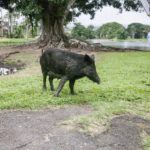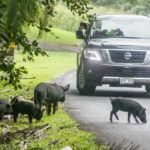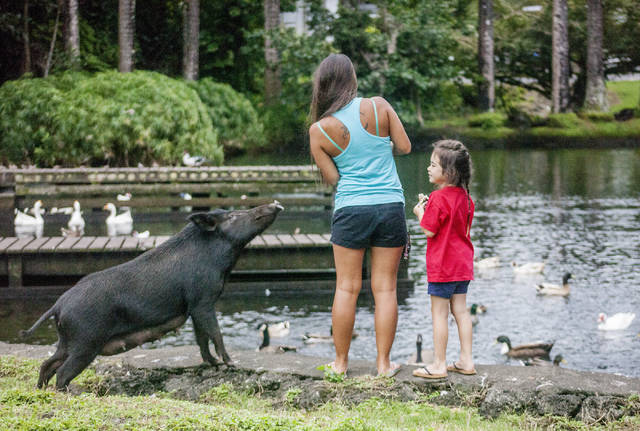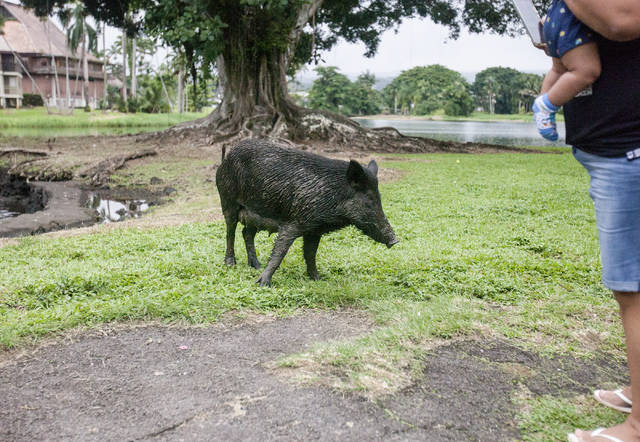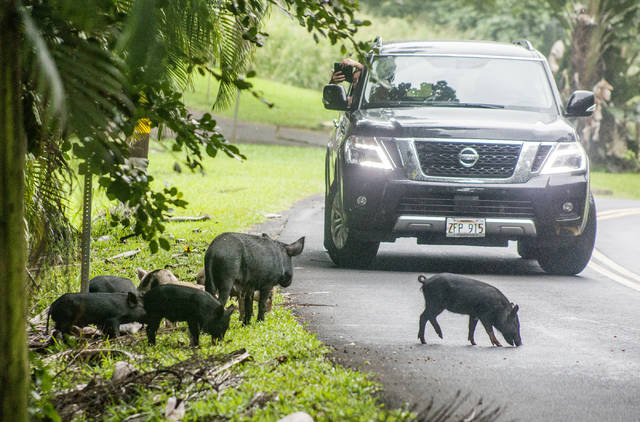A visit to Hawaii Island’s state parks provides a close encounter with nature — sometimes, a bit too close for comfort.
When two Hilo Medical Center employees, including its chief executive officer, visited Rainbow Falls in Wailuku River State Park on Wednesday morning prior to work, they found themselves scurrying back to their cars to avoid an aggressive feral pig.
“I go there every morning before I go to work,” said Michelle, a HMC technician who asked that her last name not be used. Michelle said when she arrived on Wednesday, her boss, Dan Brinkman, the East Hawaii region CEO of Hawaii Health Systems Corp., was there, as was a feral pig Michelle said had become too accustomed to being fed by people.
“The pig was going either for the garbage or for Dan,” she said. “I made noise to let Dan know and try to startle the pig, but the pig didn’t startle. So I got out of my car and was waving a piece of paper, trying to get it to go. And it just ran at me. And it did it three times, so I kept running back to my car.”
“It’s a scary thing,” Michelle added. “Usually when you try to shoo a pig away they’ll go, but this one did not. Just the opposite.”
Dean Takebayashi, Hawaii Island superintendent of the Department of Land and Natural Resources Division of State Parks said officials are aware of a feral pig problem at the Big Island’s state parks. Pig populations are established at Rainbow Falls, a popular tourist attraction in Hilo, as well as Wailoa River State Recreation Area in Hilo, Akaka Falls State Park in Honomu, and to a lesser degree, Manuka State Wayside in South Kona.
There are also feral pigs in Lava Tree State Monument, off Highway 132 near Pahoa — which remains closed to the public because of lava from this year’s Lower East Rift Zone eruption.
Takebayashi said the department has been working with its Division of Forestry and Wildlife, surrounding land owners and other agencies “to come up with solutions.”
“Although we have not had any reports of injury related to aggressive feral pigs in our parks, it would be most prudent to retreat from where the pigs are,” Takebayashi said. He said Rainbow Falls and Wailoa have signs warning the public to not feed the animals.
Michelle said she’s seen people feeding the pigs on her morning excursions to Rainbow Falls and, on one recent morning, saw a woman bitten by a pig she was feeding.
“She was petting it, and when she turned and looked away it bit her thigh,” she said. “I saw a guy just this week, maybe Monday, pull up his truck and just unload all of these avocados and all the baby pigs were right there and the mother pig. I’ve seen several people just feeding it. You can tell people are just saving up food to feed it.
“A co-worker said they saw several tourist families with young kids going towards the pig, trying to take pictures. They’re like, ‘Wow, a pig.’ And they’re going towards it. They don’t seem to realize it could be dangerous, especially when the pig has babies and they’re more aggressive.”
Brinkman said he thinks the pigs have become a problem, and added they present “a danger to the public when they become used to human sources of food and lose their fear of humans.”
“I lived in Colorado for a time and many precautions had to be taken with trash, provision for bear-proof containers, etc., in order to not encourage these animals to frequent parks and other urban spaces. When this mixing occurs, someone will get hurt,” Brinkman said.
“Feral pigs, especially sows with piglets and boars are dangerous and their bites and goring from tusks can cause substantial injuries and subsequent infections. Pigs in a group presents their own hazards. HMC regularly sees these injuries in our ER, most related to hunting, but some that are from unwanted encounters.”
Brinkman said he’s also noticed feral swine on a campus near the HMC’s extended care facility “and have asked DLNR, who owns the adjacent river property, to assist in eradicating or trapping them.”
Michelle said she called police, who referred her to the Hawaii Island Humane Society, which emailed her a list of hunters, but she didn’t consider that a satisfactory solution in a place with so much foot traffic. She said she’s considering halting her morning visits to Rainbow Falls, but added, “I don’t want to stop going there, because it makes me feel good.”
“It’s a beautiful place to go,” she said.
“I know there are pigs there, but when you’re feeding them, you’re encouraging them to come at people. And that’s my fear. That’s my peaceful spot in the morning. I have a few minutes to go before I go to work. I say a prayer and I look at the water. I’m going to have to have a stick to go there. I knew this would happen. This pig is not going to be afraid of people. I’m worried that tourists are going to be hurt, young children — and even myself.”
Takebayashi said DLNR is “always concerned about any safety issues in our parks.”
He said the public can call DLNR’s Division of Conservation and Resources Enforcement hotline at 643-3567 or the DLNR Hilo district office at 961-9540.
Email John Burnett at jburnett@hawaiitribune-herald.com.

